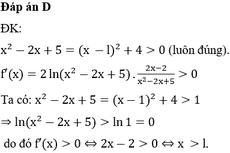

Hãy nhập câu hỏi của bạn vào đây, nếu là tài khoản VIP, bạn sẽ được ưu tiên trả lời.



a/ f(x) = 0 => x2 + 4x - 5 = 0 => (x - 1)(x + 5) = 0 => x = 1 hoặc x = -5
Vậy x = 1 , x = -5
b/ f(x) > 0 => x2 + 4x - 5 > 0 => (x - 1)(x + 5) > 0 => x - 1 > 0 và x + 5 > 0 => x > 1 và x > -5 => x > 1
hoặc x - 1 < 0 và x + 5 < 0 => x < 1 và x < -5 => x < -5
Vậy x > 1 hoặc x < -5
c/ f(x) < 0 => x2 + 4x - 5 < 0 => (x - 1)(x + 5) < 0 => x - 1 > 0 và x + 5 < 0 => x > 1 và x < -5 => vô lí
hoặc x - 1 < 0 và x + 5 > 0 => x < 1 và x > -5 => -5 < x < 1
Vậy -5 < x < 1

a) ĐK: \(x\ge0,x\ne1,x\ne\frac{1}{4}\)
\(A=1+\left(\frac{2x+\sqrt{x}-1}{1-x}-\frac{2x\sqrt{x}-\sqrt{x}+x}{1-x\sqrt{x}}\right)\frac{x-\sqrt{x}}{2\sqrt{x}-1}\)
\(A=1+\left[\frac{\left(2\sqrt{x}-1\right)\left(\sqrt{x}+1\right)}{\left(\sqrt{x}+1\right)\left(1-\sqrt{x}\right)}-\frac{\sqrt{x}\left(2\sqrt{x}-1\right)\left(\sqrt{x}+1\right)}{\left(1-\sqrt{x}\right)\left(x+\sqrt{x}+1\right)}\right]\frac{\sqrt{x}\left(\sqrt{x}-1\right)}{2\sqrt{x}-1}\)
\(A=1+\left[\frac{2\sqrt{x}-1}{1-\sqrt{x}}-\frac{\sqrt{x}\left(2\sqrt{x}-1\right)\left(\sqrt{x}+1\right)}{\left(1-\sqrt{x}\right)\left(x+\sqrt{x}+1\right)}\right]\frac{\sqrt{x}\left(\sqrt{x}-1\right)}{2\sqrt{x}-1}\)
\(A=1-\sqrt{x}+\frac{x\left(\sqrt{x}+1\right)}{x+\sqrt{x}+1}\)
\(A=\frac{x+1}{x+\sqrt{x}+1}\)
Để \(A=\frac{6-\sqrt{6}}{5}\Rightarrow\frac{x+1}{x+\sqrt{x}+1}=\frac{6-\sqrt{6}}{5}\)
\(\Rightarrow5x+5=\left(6-\sqrt{6}\right)x+\left(6-\sqrt{6}\right)\sqrt{x}+6-\sqrt{6}\)
\(\Rightarrow\left(1-\sqrt{6}\right)x+\left(6-\sqrt{6}\right)\sqrt{x}+1-\sqrt{6}=0\)
\(\Rightarrow x-\sqrt{6}.\sqrt{x}+1=0\)
\(\Rightarrow\orbr{\begin{cases}\sqrt{x}=\frac{\sqrt{2}+\sqrt{6}}{2}\\\sqrt{x}=\frac{-\sqrt{2}+\sqrt{6}}{2}\end{cases}}\Rightarrow\orbr{\begin{cases}x=2+\sqrt{3}\\x=2-\sqrt{3}\end{cases}}\left(tmđk\right)\)
b) Xét \(A-\frac{2}{3}=\frac{x+1}{x+\sqrt{x}+1}-\frac{2}{3}=\frac{3x+3-2x-2\sqrt{x}-2}{3\left(x+\sqrt{x}+1\right)}\)
\(=\frac{x-2\sqrt{x}+1}{3\left(x+\sqrt{x}+1\right)}=\frac{\left(\sqrt{x}-1\right)^2}{3\left(x+\sqrt{x}+1\right)}\)
Do \(x\ge0,x\ne1,x\ne\frac{1}{4}\Rightarrow\left(\sqrt{x}-1\right)^2>0\)
Lại có \(x+\sqrt{x}+1=\left(\sqrt{x}+\frac{1}{2}\right)+\frac{3}{4}>0\)
Nên \(A-\frac{2}{3}>0\Rightarrow A>\frac{2}{3}\).

Câu 1 :
Đk: \(x\ge1\)
\(\sqrt{x-1}+\sqrt{2x-1}=5\\ \Leftrightarrow x-1+2\sqrt{\left(x-1\right)\left(2x-1\right)}+2x-1=25\\ \Leftrightarrow2\sqrt{2x^2-3x+1}=27-3x\\ \)
\(\Leftrightarrow\begin{cases}27-3x\ge0\\4\left(2x^2-3x+1\right)=9x^2-162x+729\end{cases}\) \(\Leftrightarrow\begin{cases}x\le9\\x^2-150x+725=0\end{cases}\)
\(\Leftrightarrow\begin{cases}x\le9\\x=145hoặcx=5\end{cases}\)
với x= 5 thoản mãn điều kiện, x=145 loại
Vậy \(S=\left\{5\right\}\)

a) \(4x-7>0\Leftrightarrow4x>7\)\(\Leftrightarrow x>\frac{7}{4}\)
b) \(-5x+8>0\Leftrightarrow5x<8\Leftrightarrow x<\frac{8}{5}\)
c)\(9x-10\le0\Leftrightarrow9x\le10\)\(\Leftrightarrow x\le\frac{10}{9}\)
d) \(\left(x+1\right)^2+4\le x^2+3x+10\)\(\Leftrightarrow x^2-2x+1+4\le x^2+3x+10\)
\(\Leftrightarrow5x\ge-5\Leftrightarrow x\ge-1\)
a,
4x - 7 > 0
↔ 4x > 7
↔ x > \(\dfrac{7}{4}\)
Vậy tập nghiệm của bất phương trình là S = { x / x>\(\dfrac{7}{4}\) }
b,
-5x + 8 > 0
↔ 8 > 5x
↔ \(\dfrac{8}{5}\) > x
Vậy tập nghiệm của bất phương trình là S = { x / \(\dfrac{8}{5}\) > x }
c,
9x - 10 ≤ 0
↔ 9x ≤ 10
↔ x ≤ \(\dfrac{10}{9}\)
Vậy tập nghiệm của bất phương trình là S = { x / x ≤ \(\dfrac{10}{9}\) }
d,
( x - 1 )\(^2\) + 4 ≤ x\(^2\) + 3x + 10
↔ x\(^2\) - 2x +1 +4 ≤ x\(^2\) + 3x + 10
↔ 1 + 4 - 10 ≤ x \(^2\) - x\(^2\) + 3x + 2x
↔ -5 ≤ 5x
↔ -1 ≤ x
Vậy tập nghiệm của bất phương trình là S = { x / -1 ≤ x}

S là tập con của F trong các trường hợp sau:
TH1: S là tập rỗng, tức là pt x2 - 2x + m = 0 vô nghiệm => delta' = 1 - m < 0 => m > 1
TH2: S có 1 nghiệm kép < 0 => delta' = 1 - m = 0 và nghiệm kép -b'/a = 1 < 0. Điều này không xảy ra
TH3: S có 2 nghiệm đều < 0 => Tổng 2 nghiệm cũng < 0. Mà tổng 2 nghiệm = -b/a = 1 là số dương => Điều này cũng ko bao giờ xảy ra.
Vậy m > 1 thì S là rỗng và khi đó S là tập con của F.

Phương trình tiếp tuyến tại M0 có dạng: y = k(x – x0) + y0 (*)
Với x0 là hoành độ tiếp điểm;
Với y0 = f(x0) là tung độ tiếp điểm;
Với k = y’(x0) = f’(x0) là hệ số góc của tiếp tuyến.
Để viết được phương trình tiếp tuyến ta phải xác định được x0; y0 và k

hoành độ giao điểm là nghiệm của pt
\(x^3-3mx^2+3\left(2m-1\right)x+1=2mx-4m+3\Leftrightarrow x^3-3mx^2+4mx-3x-2+4m=0\Leftrightarrow x^3-3x-2-m\left(3x^2-4x+4\right)=0\)
giải hệ pt ta có \(C_m\) luôn đi qua điểm A là nghiệm của hệ pt sau
\(\begin{cases}3x^2-4x+4=0\\x^3-3x-2=0\end{cases}\)
ta đc điều phải cm

a) Ta có:
\(M\left(x\right)=A\left(x\right)-2.B\left(x\right)+C\left(x\right)\)
\(=\left(2x^5-4x^3+x^2-2x+2\right)-2.\left(x^5-2x^4+x^2-5x+3\right)+\left(x^4+3x^3+3x^2-8x+4\frac{3}{16}\right)\)
\(=2x^5-4x^3+x^2-2x+2-2x^5+4x^4-2x^2+10x-6+x^4+4x^3+3x^2-8x+\frac{67}{16}\)
\(=\left(2x^5-2x^5\right)+\left(4x^4+x^4\right)+\left(-4x^3+4x^3\right)+\left(x^2-2x^2+3x^2\right)+\left(-2x+10x-8x\right)+\left(2-6+\frac{67}{16}\right)\)
\(=0+5x^4+0+2x^2+0+\frac{3}{16}\)
\(=5x^4+2x^2+\frac{3}{16}\)
b) Thay \(x=-\sqrt{0,25}=-0,5\); ta có:
\(M\left(-0,5\right)=5.\left(-0,5\right)^4+2.\left(-0,5\right)^2+\frac{3}{16}\)
\(=5.0,0625+2.0,25+\frac{3}{16}\)
\(=\frac{5}{16}+\frac{8}{16}+\frac{3}{16}=\frac{16}{16}=1\)
c) Ta có:
\(x^4\ge0\) với mọi x
\(x^2\ge0\) với mọi x
\(\Rightarrow5x^4+2x^2+\frac{3}{16}>0\) với mọi x
Do đó không có x để M(x)=0

cho 2014=2013+1 thay vào ta có:\(B=x^{2013}-\left(2013+1\right)x^{2012}+\left(2013+1\right)x^{2011}-...-\left(2013+1\right)x^2+\left(2013+1\right)x-1\)
\(=x^{2013}-\left(x+1\right)x^{2012}+\left(x+1\right)x^{2011}-...-\left(x+1\right)x^2+\left(x+1\right)x-1\)
\(=x^{2013}-x^{2013}-x^{2012}+x^{2012}+x^{2011}-...-x^3-x^2+x^2+x-1\)
\(=x-1=2013-1=2012\)